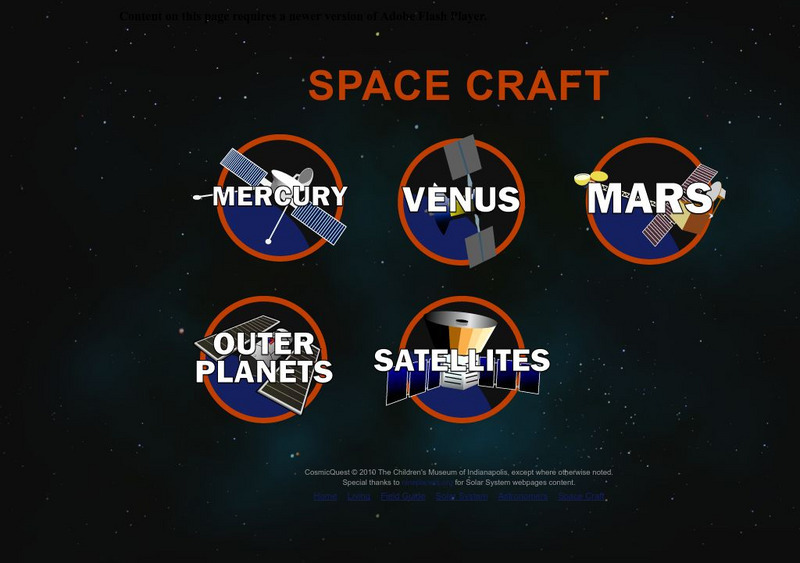Children's Museum
The Children's Museum of Indianapolis: Tie Dye Paper
Students characterize materials by their state of matter and then combined materials to create a piece of colorful, tie dye-esque paper.
Children's Museum
The Children's Museum of Indianapolis: Growing a Grass Head
Students learn about germination, or the process by which an organism grows from a seed and witness how seeds use sun, water, and soil to turn into a fascinating head of grass.
Children's Museum
The Children's Museum of Indianapolis: What's in a Dinosaur's Name?
Young scholars learn how dinosaurs are named for unique body parts or behaviors, for the location where they were found, or after a person and create their own dinosaur using the naming conventions they learn.
Children's Museum
The Children's Museum of Indianapolis: Native Americans and the Natural World
Explore the rich cultures of Native Americans through literature, storytelling, and fun, hands-on activities. Students will gain an understanding of how and where Native Americans lived in the past and today, as well as their...
Children's Museum
The Children's Museum of Indianapolis: Plants Alive: Garden in a Glove Journal
Students will observe the germination and growth of plants from seeds over the course of several days, and record their observations in a journal.
Children's Museum
The Children's Museum of Indianapolis: Mold and Cast
Students will define the term fossil, identify the difference between a mold and a cast fossil, and understand how scientists use models to learn about the physical structure of something in the natural world.
Children's Museum
The Children's Museum of Indianapolis: Measuring a Dino
Learners will begin exploring dinosaur' bodies by measuring them and comparing dinosaur size to their own size.
Children's Museum
Adventure in Theatre: Fun Things to Know About Theatre
This site is broken into fifteen separate topics covering all aspects of the theatre, including basic information on what a play is and what the theatre is to more in depth information on props, stage makeup, and scene design.
Children's Museum
Dinosphere: Dino Profiles: Meet the Didelphodon
Looking much like today's opossum, the prehistoric Didelphodon was one of the largest mammals 65 million years ago. Learn what the fossils of this animal tell us about its diet and habitat.
Children's Museum
Dinosphere: Dino Profiles: Meet Dracorex Hogwartsia
Learn about a dinosaur whose name means "Dragon King of Hogwarts." From the fossils of the newly discovered Dracorex hogwartsia, we learn about the dinosaur's unique physical features.
Children's Museum
Dinosphere: Dino Profiles: Meet the Gorgosaur
What do fossils tell us about the Gorgosaurus and how it compares to T. rex? Learn about the size and diet of this "fearsome lizard", and read about the various injuries of Dinosphere's Gorgosaur fossil. Also, "Gorgosaur 360" lets you...
Children's Museum
Dinosphere: Dino Profiles: Meet the Hypacrosaur Family
What is a Hypacrosaurus and how did they eat, live, and protect themselves against predators? Paleontologists have learned answers to these questions and others by looking Hypacrosaurus fossils. Read facts about this herbivorous...
Children's Museum
Dinosphere: Dino Profiles: Meet Kelsey the Triceratops
What does a fossil named "Kelsey" tell us about the Triceratops horridus? Learn what the fossils say about this dinosaur's defense system, diet, and size. Be sure to click the "See the skeleton" link to interact with and learn about...
Children's Museum
Dinosphere: Dino Profiles: Meet the Maiasaura
Read about paleontologist John Horner's 1978 discovery: a new dinosaur, the Maiasaura. Learn what this large creature's fossil tells us about the Maiasaura's diet and physical features. Click on "See the skeleton" for an interactive tour...
Children's Museum
Dinosphere: Dino Profiles: Meet Frannie the Prenoceratops
Learn what a fossil named "Frannie" can tells us about a herbivorous dinosaur called the Prenoceratops, a cousin of Triceratops. View a taxonomy table, learn about this dinosaur's physical features, and interact with skeleton to learn...
Children's Museum
Dinosphere: Dino Profiles: Meet Stan the T. Rex
What can a fossil named "Stan" tell us about Tyrannosaurus rex? Read about paleontologists' findings about the T. rex diet, teeth, and brain thanks to Stan, and use an interactive skeleton to view and learn about T. rex's bones.
Children's Museum
Children's Museum of Indianapolis: Floating Rock Geo Mysteries
A good resource if you want a quick overview of the formation process for igneous, metamorphic and sedimentary rock.
Children's Museum
Dinosphere: Dino Profiles: Meet Bucky the Teenage T Rex
See what a T. rex fossil named "Bucky" tells us about Bucky's life in the late Cretaceous Period and about T. rex in general.
Children's Museum
Children's Museum: Field Guide to the Universe: Astronomers
Read brief biographies of astronomers who are grouped by time period.
Children's Museum
Field Guide to the Universe: Space Craft
Pictures and descriptions of the robot spacecraft that have explored the planets and outer space since the 1960s.
Children's Museum
Children's Museum of Indianapolis: The Power of Children: Ryan White
This important online exhibit, "The Power of Children", discusses the lives of three children who faced almost unbearable challenges and become heroes of the 20th century. This page tells the story of Ryan White and his fight against AIDS.
Children's Museum
Dinosphere: Dino Profiles: Meet Baby Louie
What do paleontologist's learn from a dinosaur fossil named "Baby Louie", a baby carnivorous dinosaur from an unknown species of Oviraptors? This site offers fossil photos, a taxonomy chart, and some theories as to what happened to Baby...
Children's Museum
Dinosphere: Dino Profiles: Meet the Bambiraptor
What do the fossils of the "baby raptor" tell us about the Bambiraptor? Learn what paleontologists have learned about this dinosaur's size, diet, and skeletal system.
Children's Museum
Children's Museum of Indianapolis: What's a Hardness Scale?
Find an illustrated explanation of the Mohs' hardness scale, which is used to compare the hardness of minerals. The scale explains the differences in hardness among a range of minerals, beginning with the softest (talc) and ending with...




